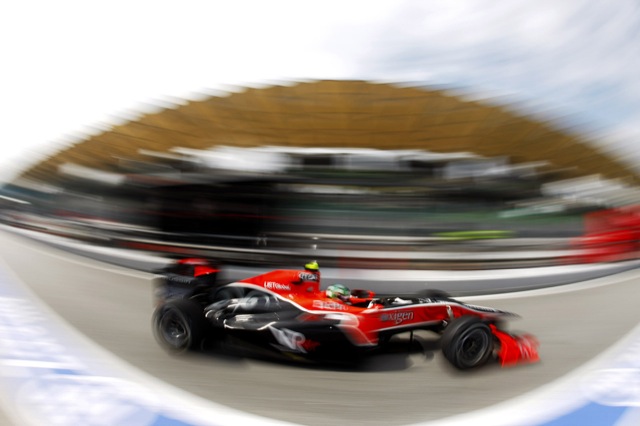FIA president Jean Todt has recently spoken of his favour of the 107% qualifying rule, essentially meaning that drivers failing to qualify within 107% of the pole-sitter’s fastest lap would be excluded from participating in the grand prix. The rule was last introduced in 1996 when some teams were performing poorly, most notably Forti Corse. The small Italian squad often found themselves unable to compete in races due to failing to make the grade in qualifying. The rule was scrapped in 2003 when qualifying changed to a one-lap procedure.
For 2010 though, the sport has seen an influx of new teams and the total grid now sports 12 squads and 24 drivers, potentially increasing to 13 teams next year. Looking at the opening free practice sessions in Bahrain earlier, Hispania Racing are clearly struggling with pace.
Nico Rosberg’s fastest lap set during the 90-minute session was 1m55.409s, meaning the 107% cut-off would be 2m03.488s had it been qualifying under the governance of this rule. Bruno Senna only managed a time of 2m06.968s while team mate Karun Chandhok failed to even get out of the garage due to a problem with his car. Under the 107% rule, both drivers would be unable to compete on Sunday if this performance continued through qualifying.
However, it is important to remember that Hispania Racing, along with Lotus and Virgin Racing are brand new teams that have never competed a Formula One Grand Prix before. Although they may employ people who are experienced, and even drivers with race wins under their belts, the team is still essentially new. Should there not be some slack given, particularly in the opening rounds of the championship while everybody finds their feet?
Or is it a case of sink or swim? Slower cars on a track can cause problems and can even prove to be a hazard. Not only does it require the front-runners to lap more cars, the inexperience in competing a grand prix increases the chances of an accident. Rubens Barrichello, the most experienced driver on the grid, may know exactly how to lap another car, knowing which side to pass on and how to move back onto the racing line, but the lapped driver may have other ideas.
[poll=”54″]

















At this point, it looks like HRT need to be saved from themselves… Remember Virgin had a front wing failure when they started testing their car. Imagine that happening to HRT! They need to be allowed to test their car during the season, surely, for safety reasons alone.
I honestly don’t see much point in re-introducing the rule. Even HRT probably won’t be in breach of this limit by Monaco and everyone else will be well clear by then. The standard is good enough as it is in terms of performance – the problem is that it’s come at the cost of instability for the new teams. Methods allowing more straightforward transition from the junior formulae are the solution to this problem, not a 107% regulation for “enforcing a standard”.
Look rule are rules,
If you are not prepared and for whatever reason you haven’t been able to test, then it is no ones fault but yours if your car isn’t competitive or even safe for that matter. If you come ready to race and your car is almost slow enough to be a danger then the race stewards have the right to park your car for that particular event.
It would be better to run fewer teams that are ready to compete than have a bigger field where one or more cars could become anothers problem. 107 % lets everyone know that you are nearer to being a worthy competitor than being a menace or potentially worse.
Wasn’t Badoer that lesson from last season ??